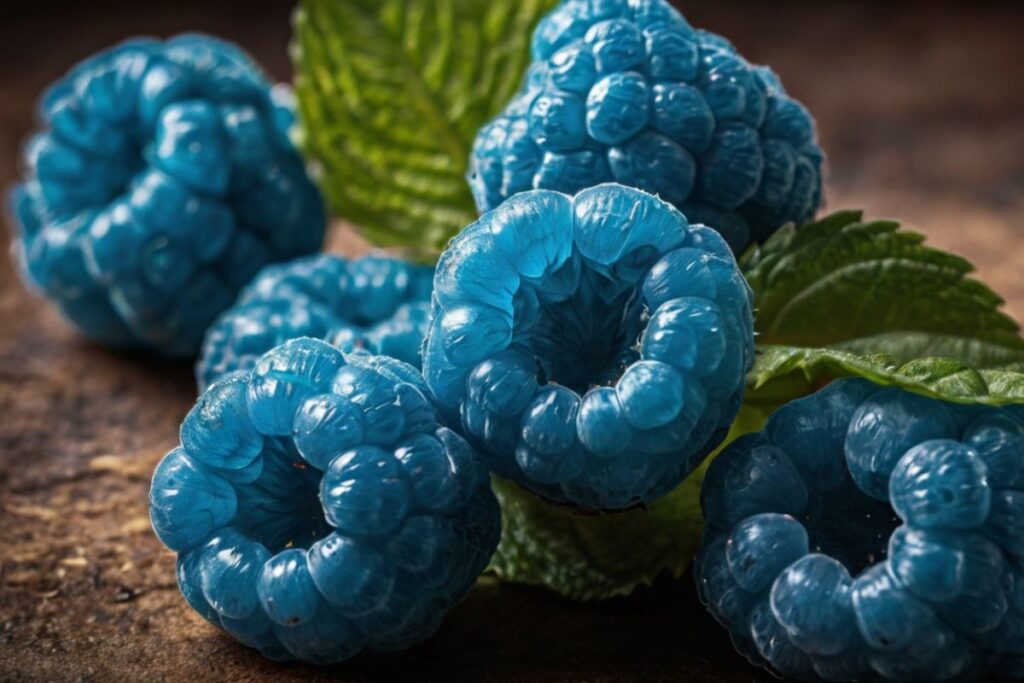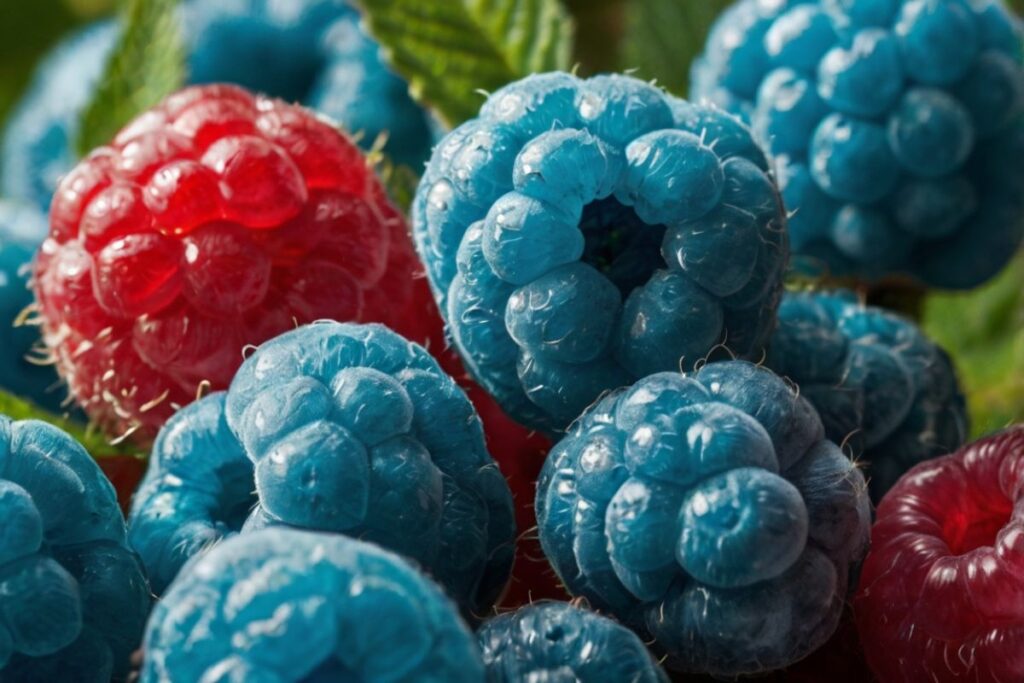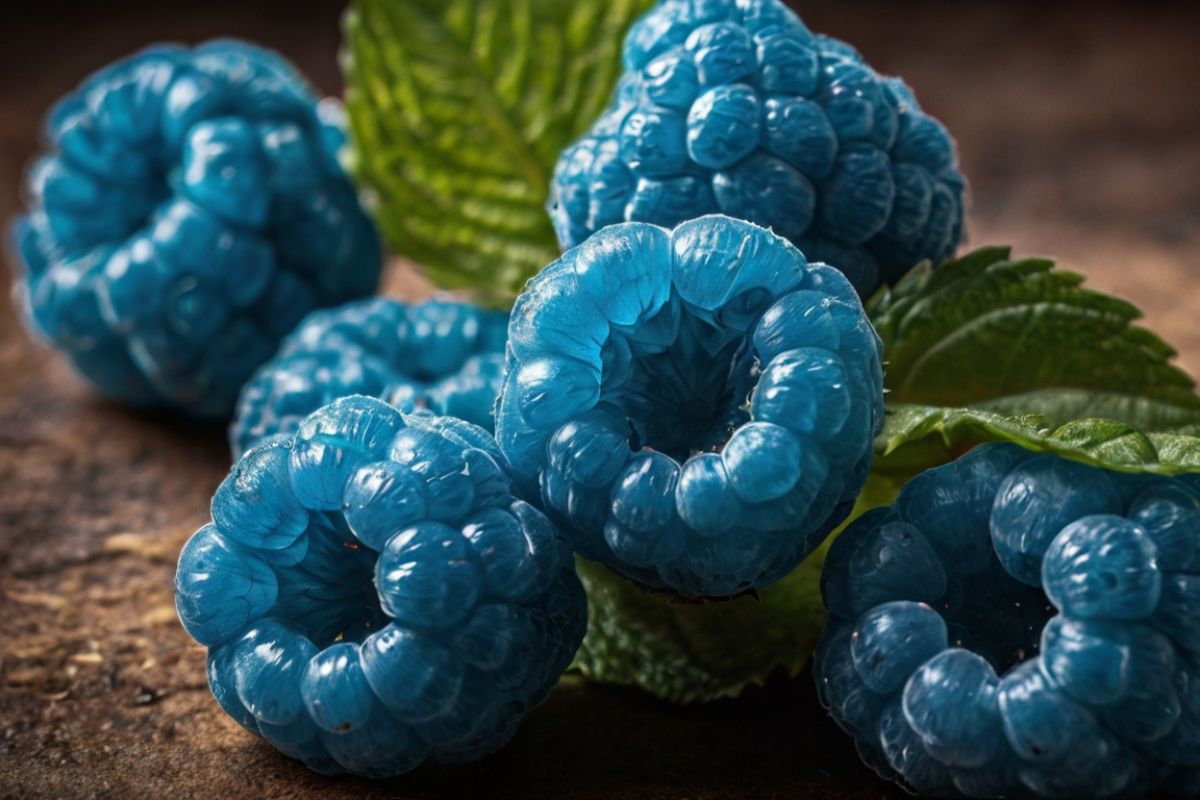Have you ever bitten into a candy or sipped a drink that tastes like blue raspberry? Have you ever wondered what that flavor really is and if it comes from a real fruit? If so, you are not alone. Many of us enjoy the bright color and sweet taste of blue raspberry.
Yet we rarely stop to ask: Does this fruit even grow on a bush somewhere? Or is it just a flavor made in a lab? Let’s dive in. We will explore the truth. We will go step by step. We will learn why blue raspberry feels real but is not.

Table of Contents
A Catchy Introduction to the Blue Raspberry Mystery
First, picture a bright blue slush. Now, imagine a candy that melts on your tongue. Finally, think of a soda that shimmers with a sky hue. All of this ranges under the label “blue raspberry.” It’s playful. It’s fun. It’s all around us.
Yet it leads many people to ask one key question: What exactly is blue raspberry, and is it a real fruit? In this blog post, we will answer that question. We will share the origin of the flavor. We will explain how it came to be. We will also tell you why it is not a fruit that you can pick off a tree.
Also read, Raspberry: Benefits, Side Effects, Nutrition, Calories, Recipes & All.
The Birth of a Flavor: How Blue Raspberry Came to Be
Believe it or not, blue raspberry started as an idea. In the 1970s, food makers looked for new flavors. They also wanted colors that stood out on shelves. Red, green, and yellow were common. Those shades blended too easily with other fruits.
Therefore, companies needed a shade that was unique. Moreover, they wanted a taste that was fresh. They picked the tart taste of raspberries. Then, they matched it with a bright blue dye. Furthermore, they created a flavor that no one had seen before. Soon, blue raspberry hit candies, slushies, and drinks.
In addition, the choice of color was key. Fruit flavors such as strawberry or cherry already used red. Lime and apple used green. Thus, blue raspberry could shine. Its bright hue caught the eye. It stood out in stores. Yet the idea felt odd. After all, raspberries are red, not blue.
However, people embraced the novelty. They enjoyed the sweet and tart mix. They also loved the color. As a result, blue raspberry grew in fame.
The Real Raspberry vs. the Imaginary Blue Raspberry

Let’s clear up the confusion. A real raspberry is a red berry. It grows on a bush. It has tiny seeds on its surface. It tastes sweet. It also tastes a bit tart. In contrast, there’s no blue raspberry bush. There is no blue berry that tastes like that candy. In fact, no fruit in nature matches the hue or the exact taste of blue raspberry products.
Some people point to a rare wild berry called the “blue raspberry,” or Rubus leucodermis. This berry grows in parts of North America. Its skin looks blue. Yet the inside flesh is white to pink. It also tastes more like a blackberry or a red raspberry.
In other words, it is not the source of the familiar blue raspberry flavor you enjoy. Hence, the bright blue candy flavor remains an artificial creation.
Why Use a Fake Fruit Flavor?
You might wonder: Why not stick to real fruit tastes? Why invent an imaginary berry? The answer lies in marketing and shelf appeal. Next, we will look at the perks of a fake fruit flavor.
First, a new color gets more attention. When you see a neon blue treat, you slow down. You take notice. Then, you reach for it. This response makes products sell better.
Second, a unique flavor becomes a talking point. Friends ask each other: What’s blue raspberry? Thus, the flavor spreads faster. In addition, candy makers can adjust the taste. They can make it sweeter or more tart. They can tailor it to kids and adults. Therefore, a fake fruit flavor gives more control than a real fruit extract.
The Science Behind the Flavor
So, how do companies make blue raspberry taste the way it does? They use a mix of flavor compounds. First, they start with raspberry keynotes. These include molecules like raspberry ketone. This compound gives raspberries their fruity aroma.
Then, they add citric acid. This acid gives the tart bite you feel. Next, they mix in sweeteners. These could be sugar or artificial sweeteners. Finally, they balance the taste until it matches the familiar profile.
Moreover, the blue color often comes from a dye called Brilliant Blue FCF. It is a safe, approved food color. It gives that electric blue look. For example, when you mix raspberry flavoring with this dye, you get a vivid result. This result reminds your brain of the taste. In fact, color plays a huge role in taste perception.
Studies show that we expect certain flavors with specific colors. In turn, our brain helps us taste what we expect. Thus, the blue color and the flavor work in tandem.
How Our Brains Work with Flavor and Color
You may be surprised. Yet color affects how we taste. For instance, if you see a red drink, you expect strawberry or cherry. If you see green, you expect lime or apple. If the color does not match the taste, you feel odd. Therefore, pairing blue with raspberry flavor tricks your mind. You perceive a new taste. You feel wonder. That magic moment adds to the fun.
Furthermore, the bright blue hue makes snacks and drinks feel playful. Kids love it. Adults enjoy the nostalgia. Even athletes grab blue raspberry energy gels. In each case, the color becomes part of the experience. It signals a burst of flavor. It tells us to get excited.
Popular Eats and Drinks with Blue Raspberry
Next, let’s explore some popular treats. First, there’s the classic blue raspberry slush. Many shops serve a frozen mix of crushed ice, syrup, and sugar. People flock to it on hot days. It tastes sweet. It tastes cold. It tastes thrilling.
Then, we have candies. Gummy bears, lollipops, hard candies, and jelly beans often include the blue raspberry flavor. When you bite them, you get a tangy punch. Moreover, the bright blue shade makes them pop in candy bowls.
Additionally, sodas and sports drinks use the flavor. You find it in limited-edition runs. You see it in neon bottles. It gives a fresh twist to familiar drinks.
Even baking recipes hop on board. Blue raspberry cupcakes and frostings have become a trend. Bakers swirl blue icing on top of vanilla cakes. The color makes the treat stand out at parties. It looks fun. It looks fresh.
Health and Nutrition: What You Need to Know
Of course, fake fruit flavors have pros and cons. They give fun tastes. Yet they may include artificial colors and flavors. Therefore, check labels if you worry about additives. If you want a healthier twist, try making your own version. For example, blend red raspberries with a drop of blue spirulina powder. This natural dye gives a blue twist. However, spirulina has a subtle seaweed taste. In addition, you can use blue pea flower tea. It turns bright blue when steeped. Then, add fresh raspberries. You get a natural blue raspberry smoothie.
Nevertheless, mass-market products will likely use artificial dyes and flavors. These items can be high in sugar. Moreover, some people may have sensitivities to food dyes. If that includes you, look for alternatives. You can also enjoy the flavor in small amounts rather than every day.
DIY Blue Raspberry Flavor at Home
If you want full control, you can DIY your own blue raspberry flavor. First, get real red raspberries. Then, extract their juice. You can do this by mashing and straining. Next, add citric acid to taste. Start with a small pinch. Taste and add more if needed. Then, sweeten with honey, sugar, or a sugar substitute.
Now comes the fun part. Add natural blue color. You have choices:
- Blue Spirulina Powder: A natural algae powder. It yields a deep blue shade. Use sparingly as it can taste earthy.
- Blue Pea Flower Tea: Steep dried butterfly pea flowers. Strain the liquid. You get a bright blue tea. Mix it with your raspberry juice. The taste stays floral and fresh.
- Red Cabbage Indicator: Boil chopped red cabbage. Strain to get a purple brew. Then, add a tiny bit of baking soda. The brew turns blue. Use it as your dye. Note: baking soda adds saltiness.
Mix these to reach your desired color. Then, store your mix in a cool jar. Use it in drinks, frostings, or candies.
Fun Facts About Blue Raspberry in Pop Culture
It’s not just candy and drinks. Blue raspberry has made its way into pop culture. You see its neon hue in art. You see it in video games. When designers need a bright wizard spell, they pick blue raspberry glow. Moreover, blue raspberry-themed parties have popped up. People decorate with blue balloons. They serve blue raspberry punch. They wear blue raspberry t-shirts.
In movies, blue raspberry shows up in snack scenes. You might notice it in quirky indie films. It signals childhood memories. It adds a pop of color on screen. Thus, the flavor has become more than a taste—it has become an icon.
Why We Love the Illusion
At its core, blue raspberry thrives because of its illusion. It mixes reality with fantasy. It makes us believe in a fruit that never grew in nature. It invites us to play. Also, it taps into our sense of discovery. We feel curious. We feel bold. We feel like kids again.
Moreover, it reminds us that food can be art. It shows how a simple color tweak can spark joy. It shows how flavor science can surprise us. That blend of science and fun gives blue raspberry its power.
Conclusion: The Sweet Truth
So, is blue raspberry a real fruit? No. It is not. Instead, it is a crafted flavor. It is a mix of raspberry keynotes, acids, sweeteners, and blue dye. It owes its fame to clever marketing. It owes its charm to our love of bright colors and bold tastes.
However, that does not make it less delightful. On the contrary, it shows how creativity shapes our taste. It shows how our minds link color and flavor. It proves that food can be a playground.
Next time you taste a blue raspberry treat, remember this story. Enjoy the moment. Savor the tart twist. Then smile at the magic of the imaginary fruit that became a legend.

